Mountain Lions in Missouri
February 7th, 2017 by BTC Editor
What is one of the neatest things you’ve captured on your game cameras? For Darryl Esthay from Louisiana it was photos of a mountain lion on a piece of property he hunts in Missouri, a very rare sight for the Show-Me-State! Being from Missouri myself, I know how big of a deal it is to the residents here to learn that there are mountain lions in our state. I contacted Darryl to get the story behind the photos and to find out what is involved in reporting a mountain lion sighting in Missouri.
The Story
According to Darryl, he went to his hunting property in Oregon County, Missouri for his final deer hunt of the year on 1/02/2017. That afternoon, he pulled his SD cards on his Browning Strike Force Trail Cameras and found this series of mountain lion pictures on one of them. He then contacted the Missouri Department of Conservation (MDC) who sent their Mountain Lion Response Team to investigate the “possible” sighting, later officially confirming that this indeed is a mountain lion.


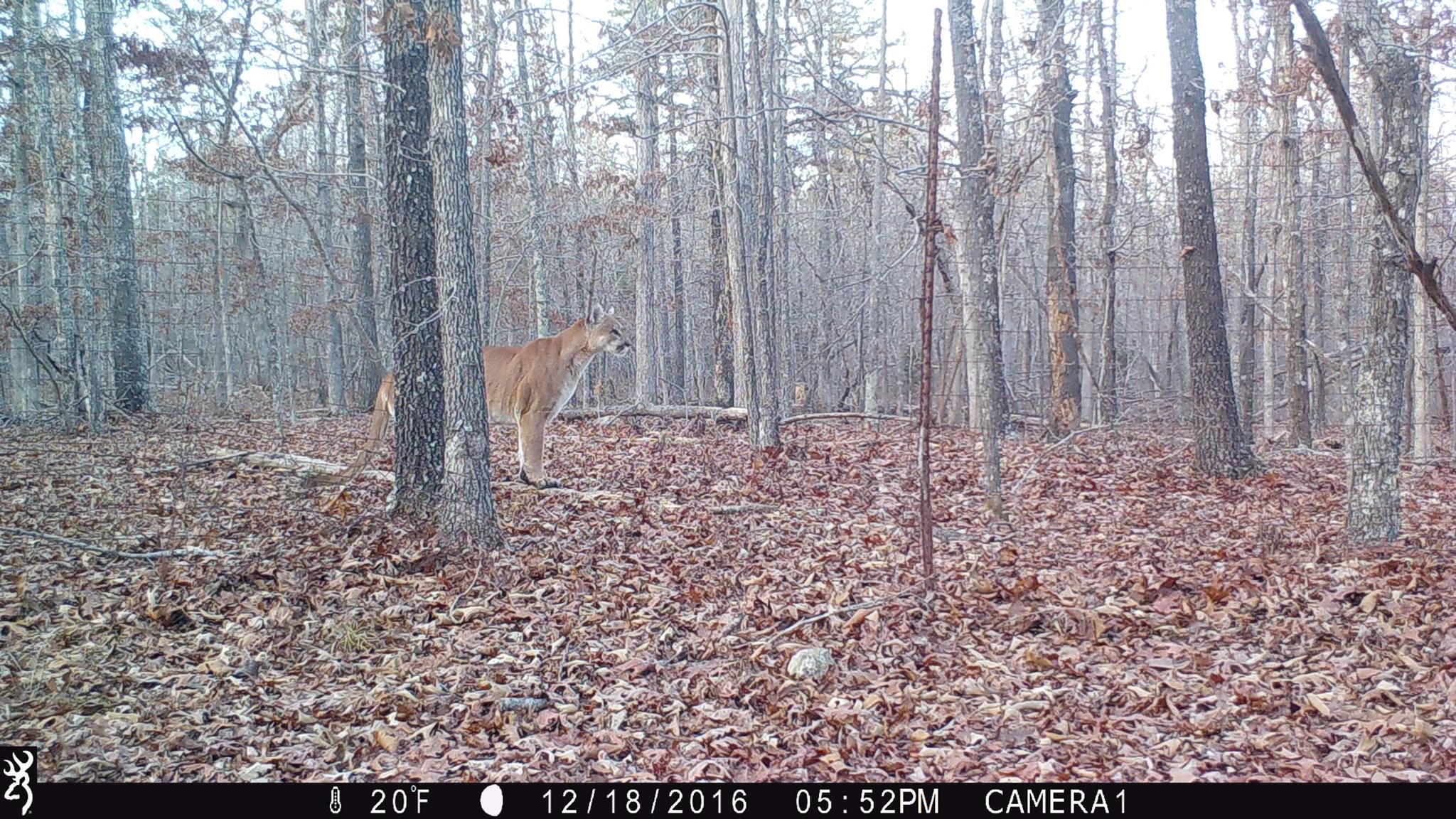
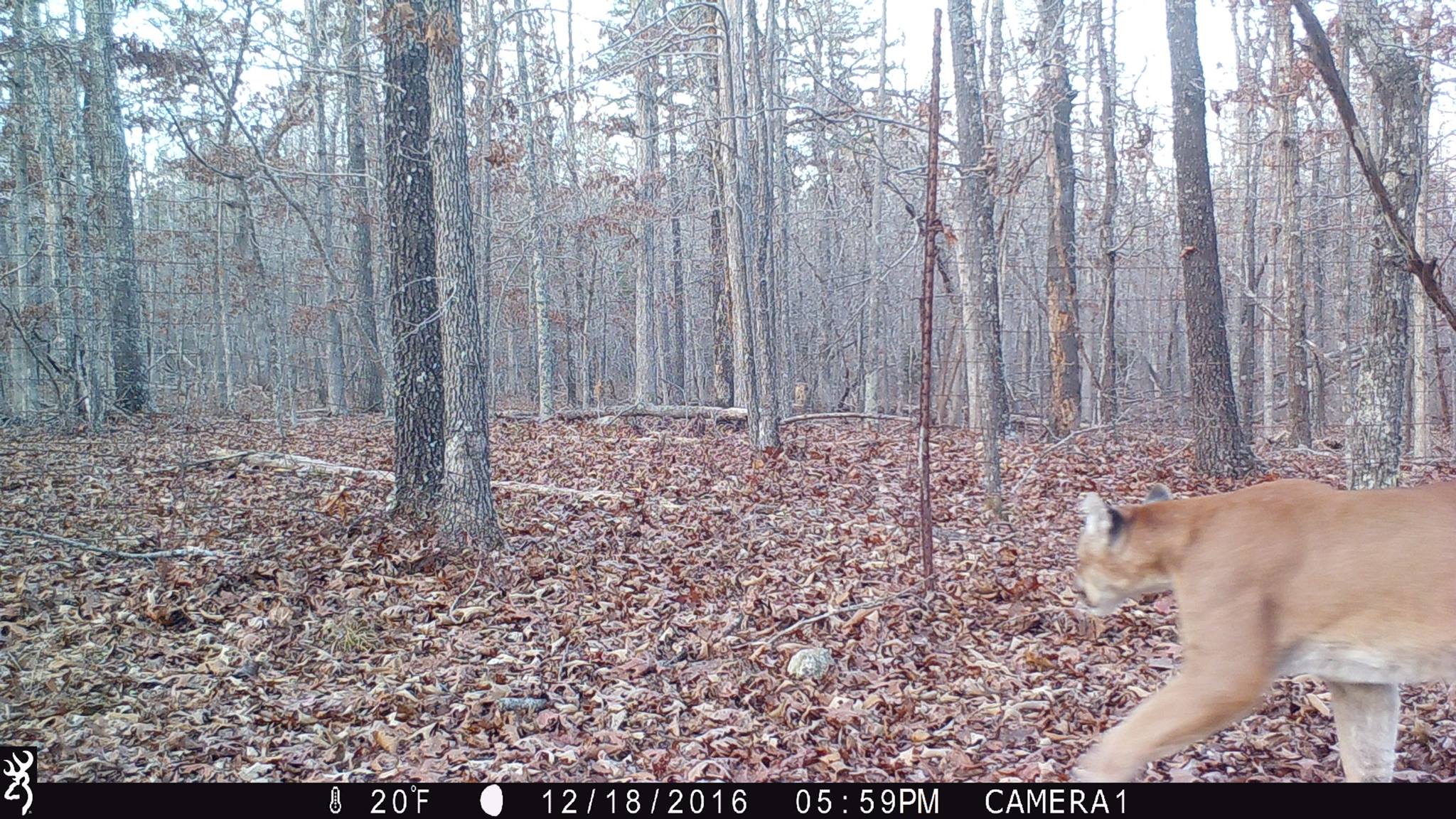
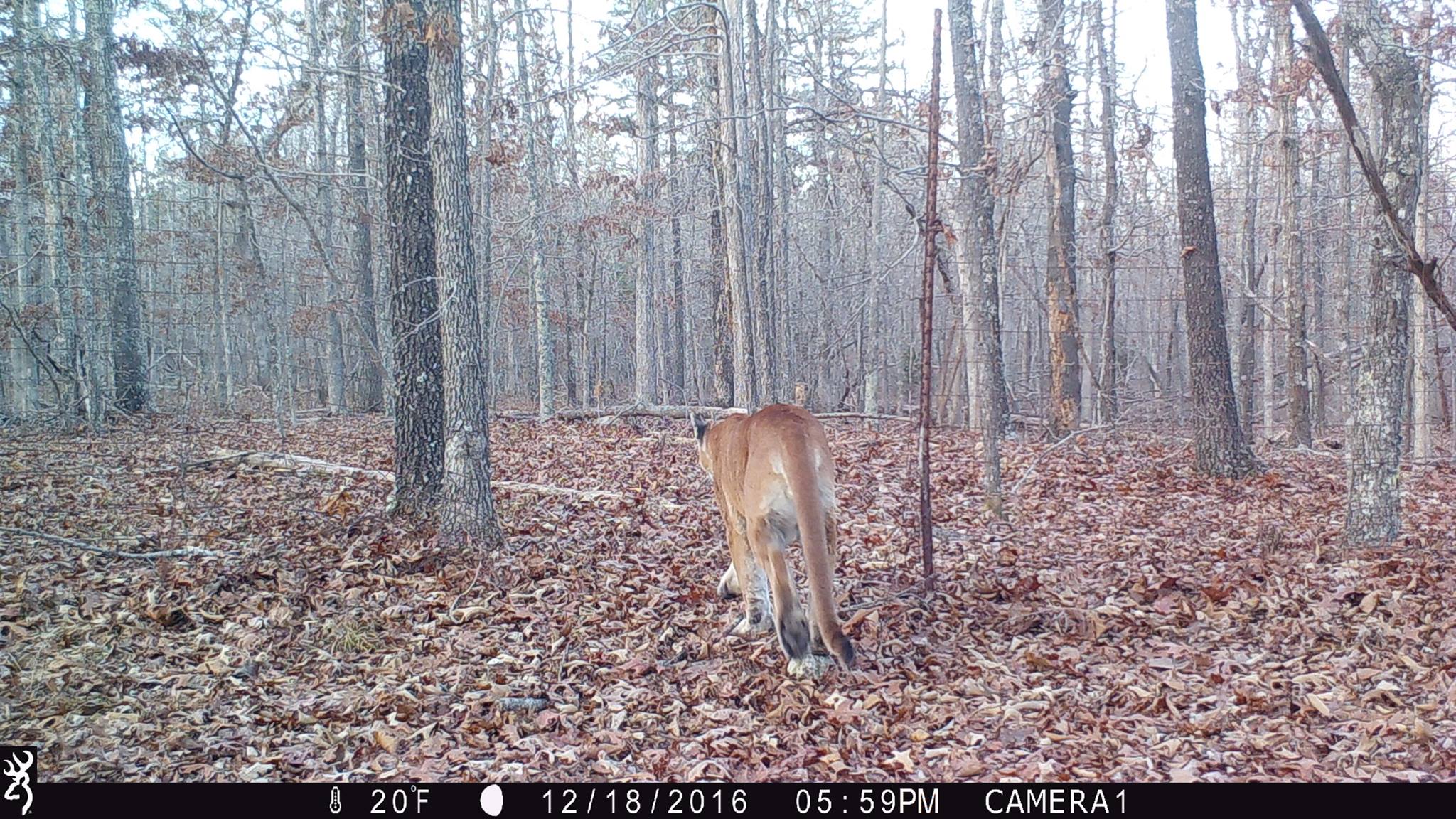
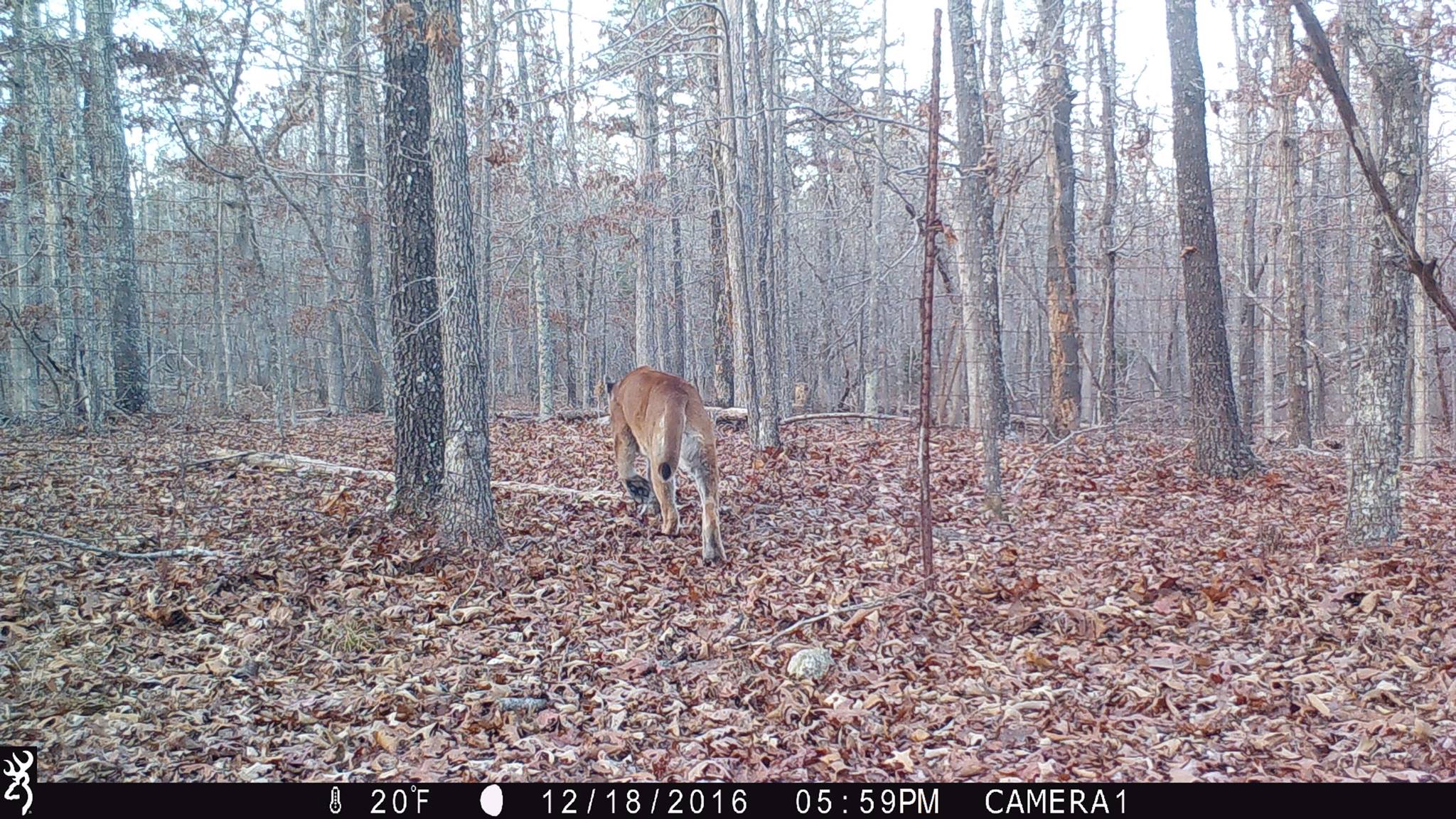
Darryl states that they were very thorough in gathering their evidence. They asked to see the original SD card that the mountain lion pictures were on, which Darryl presented to them. They saved the mountain lion photos, as well as the two photos before and the two photos after, to help support their evidence.
Next, the Mountain Lion Response Team asked to see the location that Darryl’s Browning Trail Camera was hung. They spotted the different landmarks that were in the photo: the fence, the rock & the log, and verified that it was the same location that the mountain lion pictures were taken. Darryl states that the “high fence” that is in the photos is actually an old fox pen from years ago that was there when he bought the property. He has cut 5-6 foot holes all along the fence to allow wildlife to pass through, as you can see in the photos.
After verifying the location was the same as in the photos, they then looked for mountain lion hair, scat and tracks in the area, but so far none were found. All of the gathered evidence was then presented to the entire Mountain Lion Response Team and was later officially confirmed as a mountain lion sighting in Missouri.
About a week later, Darryl also got a video of a gray fox, and what could possibly be another mountain lion in the bottom right-hand corner. The Mountain Lion Response Team looked at this video as well but they were not able to confirm that it was a mountain lion. They advised Darryl that once all the evidence is gathered after investigating a possible sighting, it is then voted on by the Mountain Lion Response Team. Each member of the team must vote “yes” in order for it to be a confirmed sighting. Even if the majority of the team believes it is, it’s not officially confirmed unless 100% of the team is positive that what they are looking at is a mountain lion.
(Click here to see a list of all of the confirmed sightings in Missouri.)
Other Evidence
Trail camera photos aren’t the only recent evidence of mountain lions in Missouri. According to an article in the Springfield News-Leader dated 1/27/17, the first confirmed female mountain lion in Missouri since 1994 killed an elk in Shannon County. Here are a couple of excerpts from the article:
“DNA from the cat’s saliva showed it likely originated from the Black Hills of Wyoming and South Dakota and northwest Nebraska. Conlee (A furbearer biologist for the MDC) said it’s a significant find because female mountain lions typically don’t travel long distances, preferring to live and hunt near where they were born.”
“There’s no indication the female mountain lion is staying in Shannon County, Conlee said, and it’s possible the cat will continue moving…Conlee emphasized there is still no evidence that Missouri has a breeding population of mountain lions.”
According to the Missouri Department of Conservation, there have been 68 confirmed mountain lion sightings in Missouri since 1994, becoming more common in recent years. This could be due to the growing number of mountain lions out west, making their way into Missouri, or could possibly be due to an increasing number of trail cameras out in the woods.
I have lived in Missouri all my life and I have never personally seen a mountain lion or gotten pictures of one on my game cameras, though I have heard stories of our neighbors seeing some behind our home for years now. My husband said his great-grandfather told his family he was riding his horse on our property one day and the horse he was on was attacked by a mountain lion. How true that is we may never know!
Part of the excitement of running trail cameras is never knowing what you’ll get pictures of. If you’ve already taken down your game cameras for the year, I suggest hanging a few back up to see what types of wildlife you get pictures of! Although it is still extremely rare, mountain lion sightings are becoming more common in Missouri. If you think you’ve seen one and have a good amount of evidence, follow this link for instructions on how to report it to the Missouri Department of Conservation.
By Andrea Haas
Andrea Haas is a Pro-Staffer from Missouri who enjoys hunting deer, turkeys, and upland birds. She is also the founder of the Huntress View, an organization formed to help strengthen the ever growing community of women hunters.
Using Trail Cameras in Trapping
December 18th, 2016 by BTC Editor
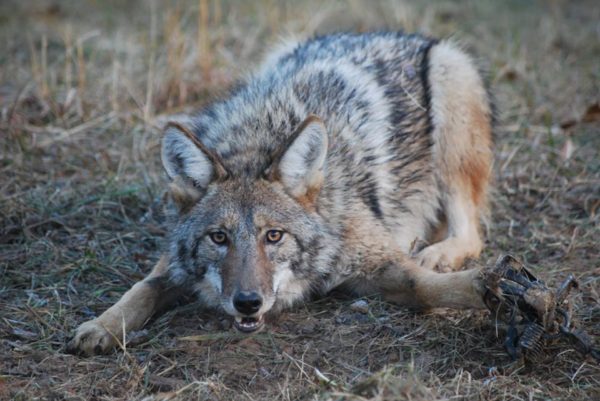
“Sometimes people wonder if animals are suffering or what exactly happens after they’re trapped. After an initial period of attempting to get away — which is why trappers run multiple swivel points and laminate the trap jaws so no paw damage occurs — the animal lies peacefully until the trapper arrives to check his traps. At that point, the trapper can decide to turn it loose or harvest it, depending on the conservation goals for the property he or she is trapping.
“Trappers are the best outdoorsmen there are,” the game warden replied when I told him I trapped. It was a routine license check while deer hunting, and once that formality was out of the way we began chatting. I don’t know if I fit into THAT category, but I certainly strive to learn all I can from those who’ve gone before me. Trappers settled this country, and their skillset often determined living or dying in those days. It’s a time-honored tradition where not much has changed: the methods, the techniques and even the equipment could easily be interchanged with those who came before us more than 200 years ago.
But there’s been one concession to modern, cutting-edge technology that has advanced the trapper’s knowledge more than any other single item: the trail camera. For years, we trappers have studied the tracks left behind of an animal at our sets, trying to figure out why he stepped here and not there. Snow is like a God-send to the trapper, and we’ll get out and follow a set of tracks for miles just to study the species we love to go after. What caused him to stray from the path he was walking there, and what attracted his attention enough to cause him to deviate from his destination?
Staggs first recorded this nice bobcat visiting his set four days before the second time it made an appearance; another added benefit of using trail cameras while ‘cat trapping is helping to pattern them, as big males will often make a 5-day loop around their territory.
With the technical advances in trail cameras over the past decade or so, a treasure-trove of information is now readily available to the average person, and chief among those questions that get asked more than any other: How does animal XYZ work a set? Tracks give clues, but there’s nothing like actually WATCHING a bobcat tip-toe gingerly through your walk-through set… or a coyote approach your dirt-hole set from the side, because he didn’t know that the “front” of your set was the front.

Pictures are great, but video mode and the information it captures is priceless. Invisible night-vision infrared LED illumination is a must when capturing predators on video like this; if they see a red glow light up the area, they’re gone … and unlikely to return. Give it a try sometime if you’re a trapper, and see how much your knowledge base is increased. Or, even if you’re not a trapper, you may enjoy expanding your horizons beyond merely trying to capture deer on camera. The next time you’re in a Bass Pro or Cabela’s, or even an old hardware store that may have a trapping section, pick up a bottle of gland lure. Dip a bit out with a Q-tip and place it under a fallen limb on the forest floor. You may be amazed to see the number of predators you get video of which you had no idea were around.
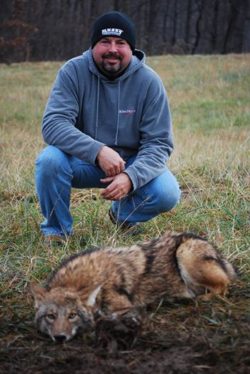
Greg Staggs is the former back-page columnist for Inside Archery, and his writing regularly appears in such magazines as Outdoor Life and Petersen’s Bowhunting. Staggs loves introducing his two boys to all things outdoors, including fishing, trapping, canoeing and camping, and has been chasing turkeys and big game exclusively with archery equipment for over 20 years.
D.E.E.R. Project
October 9th, 2016 by BTC Editor
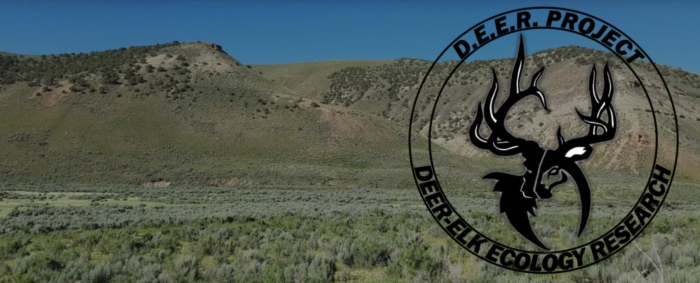
D.E.E.R. Project
By Matthew Hayes
Mule deer have a complex history throughout the western United States. In the days of the early settlers and pioneers, mule deer were relatively scarce; many trappers and explorers reported only occasional sightings of mule deer whereas other big game species were regularly observed. At the beginning of the 20th century, mule deer populations had been drastically reduced in number due largely to overharvest, market hunting, and overgrazing. Protections were put in place in the early to mid-1900s, eventually leading to ideas such as the North American Model of Wildlife Conservation, which was followed by a dramatic increase in mule deer populations. Mule deer populations peaked between the 1940s to the early 1960s throughout the western US.
Fast forward a few decades to the present day. With a lens to examine population fluctuations over the past 40+ years, a clear pattern has emerged. Populations, at least in Wyoming, appear to go through cyclical periods of increase followed by sharp declines. In reviewing literature and historical documents, concerns about mule deer populations tend to follow huge decreases in populations and when they subsequently rise, research and management become less important. Another point that seems clear in Wyoming is that although we have this see-saw in population numbers, there is a general declining trend since at least the 1970s. On average, Wyoming has seen a roughly 20% reduction in mule deer populations.
The population swings, and general decline, of mule deer since the 1970s has been difficult to understand. A variety of factors have been proposed to explain these declines, including: overharvest, harsh winters, habitat, drought, predation, disease and burgeoning elk populations. Managers have long noted that many areas that mule deer inhabit face different pressures and that populations are likely being driven by a variety of factors. All factors are not influencing populations in each portion of their range. This complication has meant that gaining a more complete understanding of reasons for fluctuations or stagnant growth in population numbers has been elusive. Without a solid understanding of the why and how associated with population fluctuations, it is incredibly difficult for targeted management to be beneficial.
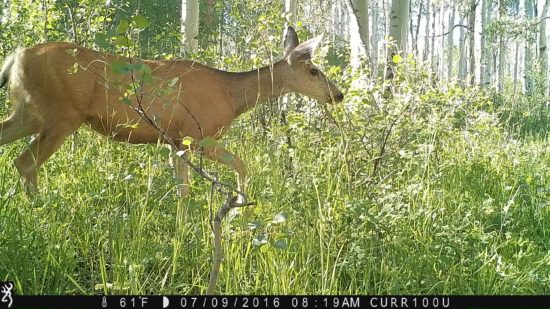
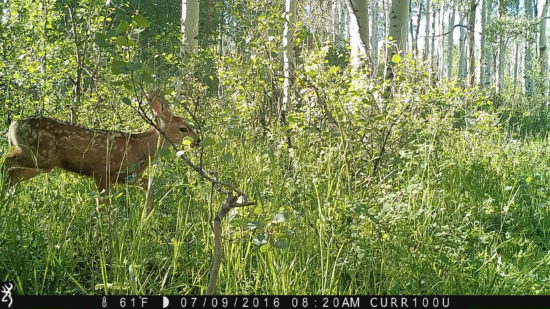
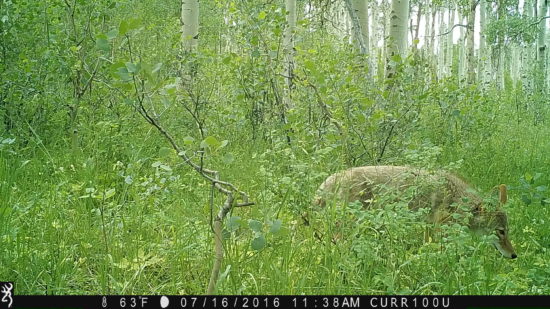
Researchers and managers have made great strides to better understand mule deer ecology and factors relating to their survival and reproduction. In the early 2000’s Global Positioning Systems (GPS) became small enough to fit onto a collar sized for ungulates. Since then, studies have been conducted examining migration and use of the landscape in summer and winter. The effects of drought and shifting precipitation regimes have been investigated as well as determining when, where and how animals are dying. Wyoming has been at the forefront of this research and has helped to better understand the ecology and management of mule deer. A key ecological process that has remained poorly understood are the interactions between mule deer and elk (though some work has been done at the Starkey Experimental Forest).

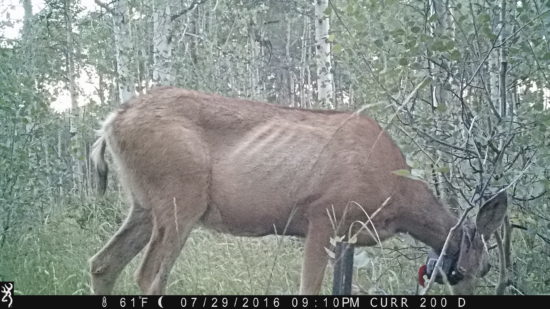
Mule Deer with GPS tracking collar.
Both mule deer and elk are highly cherished big game species. Wyoming and her residents rely on these animals for hunting, tourism and as a part of our cultural heritage. Nevertheless, at the same time those mule deer populations have generally declined, elk populations have increased dramatically across the same geographical range. Managers and researchers have long wondered if mule deer and elk could be competing for space and resources but, until recently, the ability to study these interactions was almost impossible. Potential for interactions between these 2, highly valued species to affect one another’s abundance has been a bit of a conundrum for decades, probably given the challenges associated with addressing such a complex question. The Deer-Elk Ecology Research Project (DEER) was ultimately incepted out the need to unravel the head-scratching complexities of poor performing mule deer populations, while a similar big game animal continues to grow in the same country.
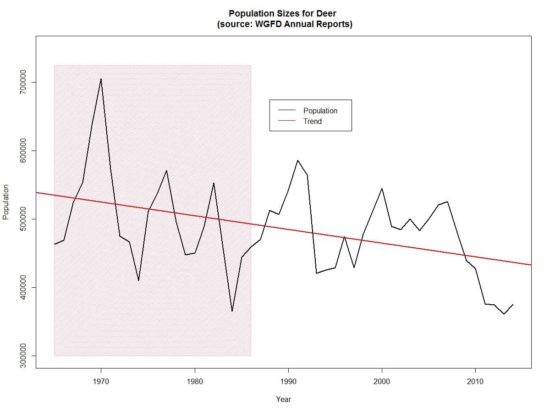
Population sizes for Deer

Population sizes for Elk
The DEER Project, located in the Greater Little Mountain Area of southwestern Wyoming, aims to increase our understanding of both mule deer and elk. This project is examining parturition timing and location of mule deer, mortality and recruitment of fawns, nutritional condition of adult female mule deer, summer diet overlap between elk and mule deer, space use, recruitment of male mule deer, survival, migration, and dispersal. We also are implicitly examining winter severity, habitat use, precipitation patterns, predation and disease. One of the greatest strengths of this work is the rigorous monitoring of both mule deer and elk in the same system. Many studies prior have examined one species or the other with inference to supposed interactions, but the DEER project will be able to analyze these interactions at a much finer scale. Another added benefit of this project is that it occurs in a high-desert system—an ecosystem ubiquitous throughout Wyoming but less studied compared to high-elevation systems. Far from being a one-off or unique system, the results from this work will be applicable to mule deer and elk throughout their shared range.


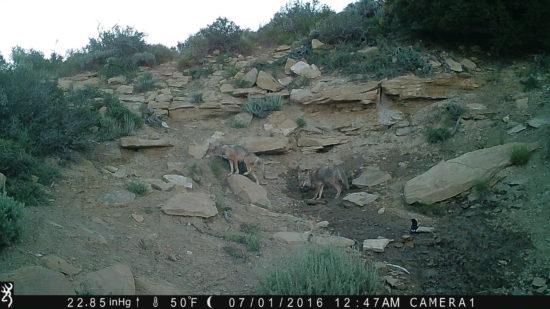
Future articles will focus on updates from the DEER project. You can follow along with the project, donate and subscribe for updates at www.deerproject.org.
The Western Association of Fish and Wildlife Agencies (WAFWA) has explored the issue of mule deer decline in depth and has published a very approachable book on the topic; you can check out the website at www.wafwa.org and navigate to the Mule Deer Working Group for more information.


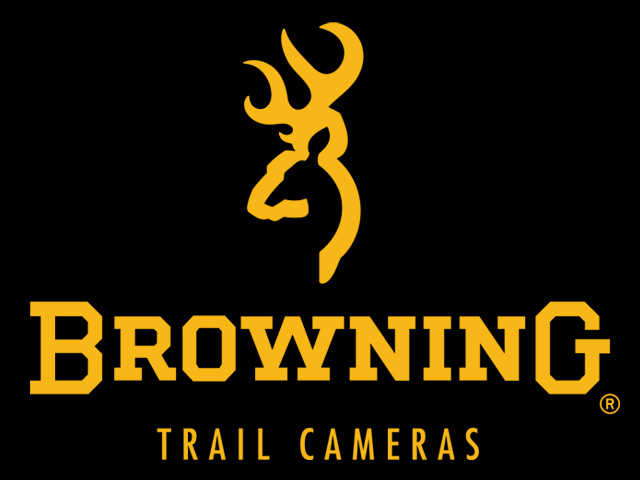
FOR MORE INFORMATION: 
UNIVERSITY OF WYOMING
Kevin Monteith 307-766-2322 kevin.monteith@uwyo.edu
Matthew Hayes 307-766-5417 mhayes1@uwyo.edu
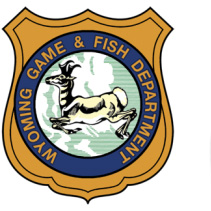
WYOMING GAME & FISH DEPARTMENT
Patrick Burke 307-875-3223 patrick.burke@wyo.gov
Mark Zornes 307-875-3223 mark.zornes@wyo.gov
Kevin Spence 307-875-3223 kevin.spence@wyo.gov
Archery Tips with Levi Morgan
September 18th, 2016 by BTC Editor
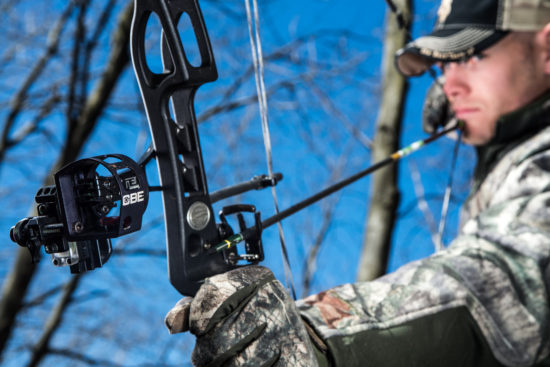
BTC: What steps do you go through mentally when you draw back on an animal to ensure your form is right and to help calm your nerves?
Levi: You know it’s funny, I don’t think. I think it’s all in practice when you do that because everybody, including myself, when you get out there in the woods and that buck of a lifetime steps out, no matter how hard I try or how much I tell myself, “Hey, I’m going to really slow down next time and I’m going to think about what I’m doing”, I look back and go “Man, that was a blur. You know, I don’t even remember that.” I don’t remember what I did, I don’t remember why I did it, so I think It’s so important to not just get your bow and go out and shoot just once every couple of weeks or get it & take it out 3 weeks before season, because you have to create that muscle memory and teach yourself to slow down and practice.
One thing I do is hunt with a caliper release. When a big deer would come out, I would draw back and get in such a hurry that when my pin got there I would just press the release off. I wasn’t really freaking out or anything, but I was rushing the shot every time. I was afraid the deer was going to run or it was going to see me, I was just nervous. So when I need to slow myself down, I started hunting with what’s called a back-tension release, or a hinge release, which forces you to slow down. You can’t shoot it fast or it’s an epic fail, so it forced me to slow down.
I really feel like it’s easy to say, I’m going to think about all these different steps when a big buck comes out. But the truth of the matter is, I really feel like people are going to do what comes naturally to them, which is why I think it’s so important beforehand to be prepared and have your equipment fit you perfect. Really get to know it and shoot it all the time because when you get nervous and everything goes blank, you’re going to revert back to what you do naturally with that bow and the way you practice with it. I really think that’s the best way to be prepared for the moment of truth.
Also, when I’m sitting in the stand or when I’m out hunting sheep, I imagine opportunities happening. For instance, if a buck comes down that trail, where am I going to shoot him at? Where am I going to stop him at? How is he going to be angled if he’s on that trail or if he walks out into the food plot? I try to imagine every scenario that could happen to me while I’m sitting there or while I’m hiking so when it does happen I’ve already kind of played it out in my mind that I’m going to stop him here and he’s going to be perfectly broadside or a little quartered away.
Obviously in hunting, you never know what’s going to happen, but that has helped me before. Nothing is as important as just being really prepared.
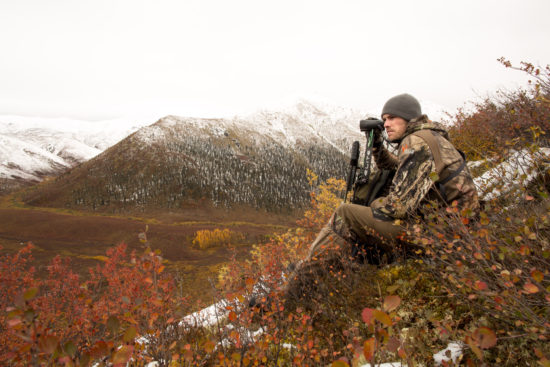
BTC: A lot of archers and bow hunters struggle with target panic. What advice do you have on how to overcome this?
Levi: Target panic is probably the most common thing in archery. I think almost everybody has been through it at one time or another if they’ve shot a bow long enough. There are so many causes of it and because of that there are a lot of cures. I think some of the main causes of target panic are too heavy poundage, too long of a draw length, or not having equipment that fits you. Also things like your peep being too small and things in your sights that are making you too uncomfortable, for example your pins being too small to see, the target being blurry…All of those things can cause it.
Another major cause is holding your breath when you shoot. I’ve talked to professional fighters and doctors about that. When you hold your breath the first muscle that starts to break down is your eyes. That’s a huge cause of target panic so that’s why it’s so important to keep breathing. I’ve seen people pull back, hold their breath and aim too long and just feeling like they HAVE to shoot now. That’s really all that target panic is, no matter what the cause, is when the pin hits the target they feel like they have to shoot now.
I think the best cure for target panic is to stand in your yard, pull back and aim at the target with your arrow loaded and finger on the release. Put your pin in the middle and leave it there but don’t shoot the arrow. When your pin starts to go, let it down. Take a few seconds to regroup, then pull back and aim at the target and let down again without shooting. Do that over and over for however long you normally practice for about a week or so. All that’s doing is letting your mind know, “It’s ok for my pin to sit there. I’m in control. I don’t have to fire this shot”. Also what it’s going to do, is you’re going to aim at the middle longer and longer, allowing you to build up that confidence and stamina to keep your pin in the middle longer to let you execute that perfect shot.
I think that’s one of the best drills there is. It lets you just focus on aiming, relaxes your mind and lets yourself know that it’s ok to aim at the target and not fire that arrow as soon as the pin gets in the middle.
BTC: What are some of the bad habits you’ve had as an archer and what helped you the most in overcoming them?
Levi: I think my worst habit, as a hunter and shooter, is when I get in a hurry. I go out and practice just to be practicing. Practicing numb is what I call it. I think when you stop trying to get better, you’re going backwards. For me, I think it’s really important to count on myself, even in practice. I don’t go out and shoot at 30 or 40 yards at the same dot every day. I try to challenge myself, whether that’s moving back further distances or trying to hit so many arrows in a row on a certain dot. Whatever games you can play to make it fun for you, that makes you challenge yourself and keep trying to get better every single time you practice and not get complacent. What should be 4 inch groups at 40 yards may be plenty good to go hunting, but it’s not the best that you can do. I think a lot of people say, “Well that’s good enough”. I’ve heard it so many times. It’s easy to do that when you’re shooting good enough but it’s important I think, for me especially, to keep challenging myself and keep trying to shoot better groups at further distances and really keep it fun and interesting during practice.
BTC: You’re going to Alaska soon to hunt sheep as part of your quest to complete the Super Slam with your bow. How far are you from completing the Super Slam?
Levi: There’s 29 animals in the Super Slam and I have killed 17 of the 29 with a bow, so I’ve got 12 left.
BTC: Which animal has been your favorite to hunt so far?
Levi: Probably my Dall Sheep in the Yukon. It was the hardest. I guess it felt the best when it was over. It was the most satisfying when the hunt was done because of how hard we had to work. We spent 14 days on horseback (The episode just aired the evening we talked on the Sportsmen Channel).
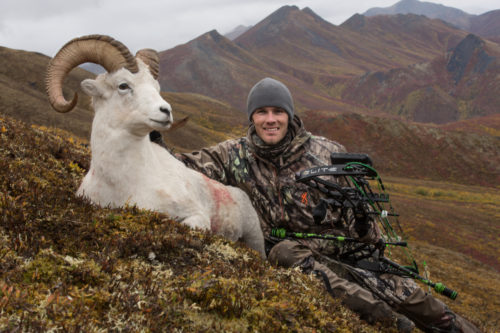
BTC: Do you have any advice for others who are wanting to complete the Super Slam?
Levi: Yes. Go to their website, www.superslam.org. The first thing I would say to do is to become a member of Super Slam because they give away hunts every month, and these adventure type of hunts are not cheap or easy to go about getting.
Also, do a lot of research. These are not your normal types of hunts. I grew up a whitetail guy, hunting whitetail in the Midwest. When I started doing these hunts, going to the Arctic, Mexico, the Yukon and all over the world, it was just a wakeup call on what gear I needed and how little I actually knew about my equipment. I think it really teaches you a lot when you go to those places and you’re riding on a horse for 14 days. You never know when something can go wrong, so get to know your equipment really well, do your research on what you need to take, and don’t cut corners on your gear. The weather is so uncontrollable out there on these adventure hunts.
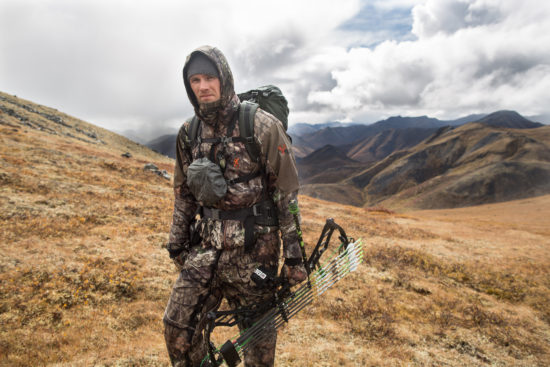
Jason Bosaw of Whitetail Freaks – 9/11 Interview
September 11th, 2016 by BTC Editor

BTC: Do you recall where were you and what you were doing on 9/11 when you heard about the terrorist attack? What type of impact did those events have on you as you watched them unfold?
JASON: Yes, I remember exactly where I was and what I was doing. I was working on the grain dryer at the farm. I was just very surprised that something of that magnitude could happen on American soil.
BTC: We understand that you are very committed to serving your community as firefighter. How challenging is it to manage both your farming and your hunting when you could get a call to respond to a call at virtually any given moment?
JASON: I am very committed to my job and my service as a firefighter, as well as to hunting. I am on call virtually 24 hours a day but my job and the firefighting come first. Balancing the two is sometimes difficult, but my willingness to help someone or their property comes to the forefront.

BTC: In your work with the Fire Department you have probably learned to stay calm and focused high stress situations. Has this helped you out at all in the moment of truth to keep from getting buck fever?
JASON: No matter how calm I may be able to stay at the response scene, it is nothing like when a big buck walks out in front of me. My heart still wants to beat out of my chest and my adrenaline level is sky high. I don’t think I will ever be able to contain that. They are two totally different scenarios.
Jason is one of the original Whitetail Freaks and counts his family and serving his community among his passions outside of his pursuit for the next great whitetail he encounters…
Ken Haas of Whitetail Freaks – 9/11 Interview
September 11th, 2016 by BTC Editor
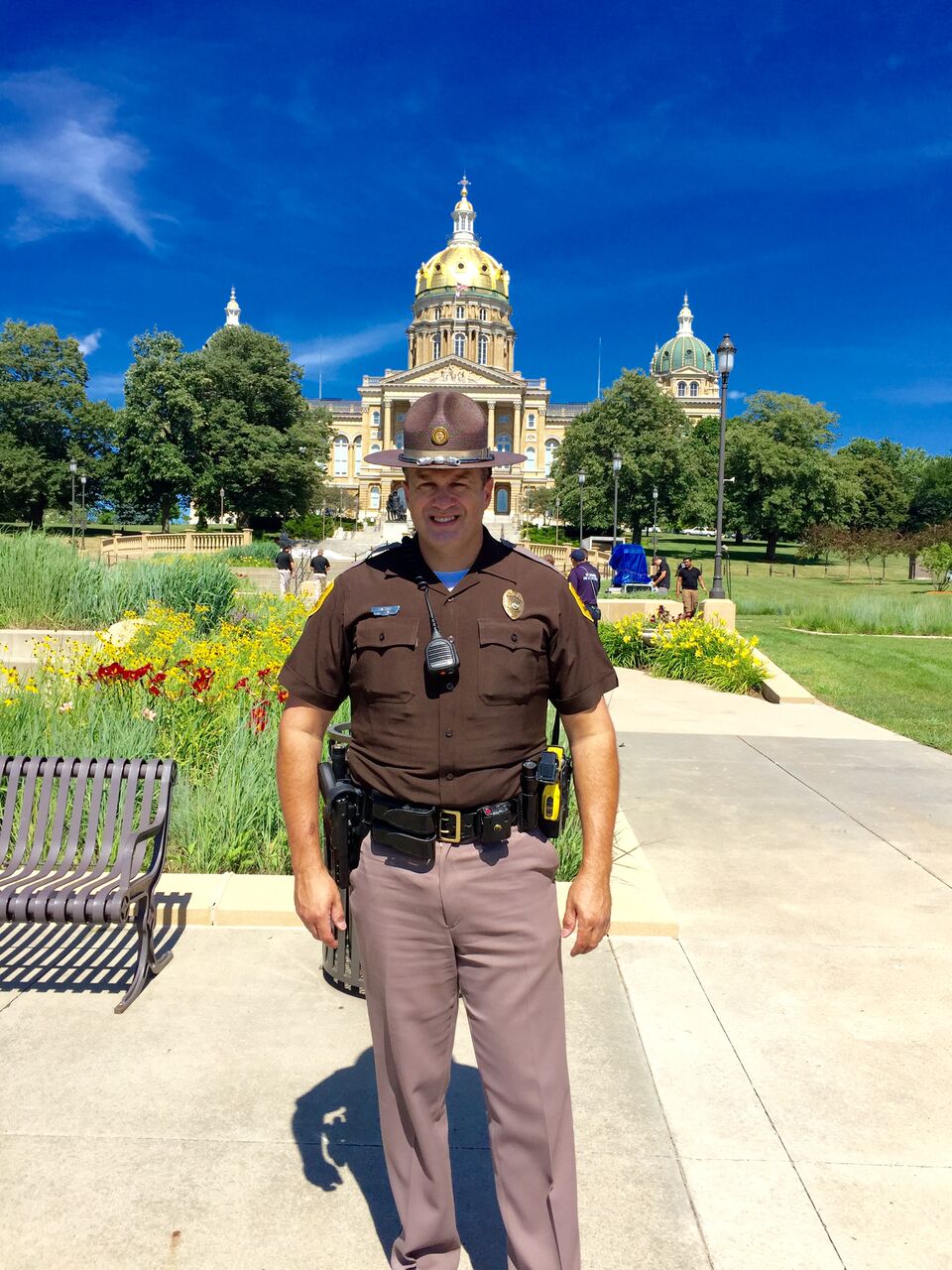
BTC: Do you recall where were you and what you were doing on 9/11 when you heard about the terrorist attack? What type of impact did those events have on you as you watched them unfold?
KEN: I was sitting in a grocery store in Council Bluffs, Iowa eating breakfast with two other Troopers while the news was on. We all watched in utter disbelief as the second plane hit the tower. All of us there were prior military and we all had the same gut wrenching feeling that we were under attack and felt very helpless watching the entire event unfold. I remember that day being very quiet and the airways going quiet as all air traffic had been grounded. Living equal distance from Offut Air Force Base and Omaha Eply Airfield it was eerily quiet. It was a huge surprise to see a plane I knew well fly by, that being Airforce one descending into Offut Airforce Base, which was no doubt bringing the President to the center of the country for safety.
As our soldiers continue to fight overseas, it is our job as Peace Officers to protect our country’s border to border against foreign and domestic terrorists. Extremist groups are a constant threat and the uniformed officer, sometimes referred to as “The Thin Blue Line”, are without a doubt this country’s greatest assets when preventing, disrupting and deterring future acts of violence and terrorism.
Few people know that terrorism is funded in part by the sale of drugs. The exploitation of the United States and its unfortunate appetite for elicit and illegal drugs is problematic when we spend billions of dollars on heroin that has been imported from overseas. I mention heroin first because of the horrible impact it has on our people, but I do not disregard the impact of the other drugs that are imported as well. As you start to see the larger picture of what is happening, you will understand that the facts of our purchasing these illicit drugs is devastating. That same money used from the sale of drugs will then go back into the pockets of terrorist organizations, allowing them to continue to fund their attacks on the United States and the rest of the world.
As with anybody that watched the unfortunate events unfold on September 11th, that day will never be forgotten. The loss of life, the bravery of the firefighters, the police and other EMS personnel, their memories will not be forgotten. It has been my experience that no matter how bad the tragedy, there is always something to be gained from it. In this case, understanding what funds terrorism and that the profit has cost the world thousands of lives lost unnecessarily, has fueled my motivation and the motivation of many others. The world’s worst criminals are the most vulnerable while they are in transit. By intercepting them we are able to make the biggest impact where we can.

Ken and his significant other, Malissa Driver. She’s a flight nurse and they are a family committed to public service.
There are many other stories like mine and my arrest of the terrorist suspect (see newspaper article below) that never see the light of day for security reasons, but rest assured uniformed and plain clothed officers are out every day doing their best to ensure that these major criminals do not travel freely to commit acts of violence throughout the country. I also take great pride in educating police officers from every type of policing agency across the country in criminal and terrorist apprehension training. I have instructed for more than 10 years in the state of Iowa, educating our officers and working for a private program called Desert Snow. I have traveled to almost all 50 states and shared what I have learned with thousands. I also take great pride in hearing about the success stories from the officers following the training.
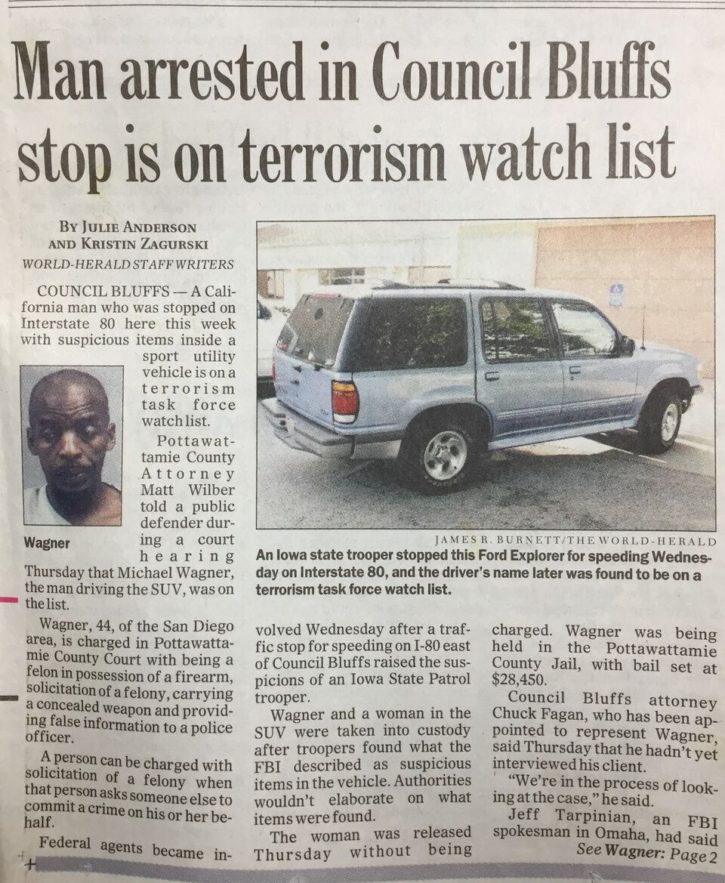
A newspaper article about a terrorist suspect Ken arrested
In 2011 in Glendale, Arizona I was given the distinct honor as being chosen as the United States 2010 and 2011 Bob Thompson Criminal Interdiction Officer of the Year by the United States Department of Transportation, the United States Department of Justice, the Drug Enforcement Administration, the Drug Interdiction Assistance Program, the El Paso Intelligence Center, and the former recipients of this prestigious award. I have very humbly received many awards in my career, but all of them ill in comparison to sharing and continuing to share what I have learned to educate new officers in the same principles for understanding and recognizing when criminal activity is afoot. That impact, no matter how significant, will change the course of someone’s life in a positive way.
Most importantly, I hope people understand that the Peace Officers of this country cannot do the job without the support of its citizens. As I travel and teach officers across the country, the sentiment from those officers and their communities that they serve is the same. The officers are being overwhelmed with gratitude from the good citizens of this country who didn’t understand that this is not just a Peace Officers fight, but this is a fight that includes everyone in our nation. We who serve without a doubt need the support of our communities and the willingness of those people to share information with us when they see things that are not right. I believe it is this cooperation that will continue to keep our country and its people safe. And those that continue to help law enforcement have my unwavering gratitude and appreciation for their continued help and their dedication to the protection of our communities. For those that have gone out of their way, and for everyone that has taken the time and thanked a Peace Officer, fire fighter, or EMS personnel, I thank you!!!! You, are the people that I am talking about.
BTC: What do you feel is the most rewarding about your job as a state trooper?
KEN: The most rewarding part of my job is tough. It has many facets that stretch out in many directions. Being a first responder and saving lives is huge. So is protecting the innocent from crime and the relentless pursuit of major criminals on our nation’s roads. Few people consider the fact that all crime is, at some point, in transit: the people perpetrating the crime, the proceeds of the crime, the tools to facilitate the crime, or evidence of a crime committed.
BTC: What skill sets learned from your job and training have helped you the most as a hunter?
KEN: So you might ask yourself, “What does this have to do with me hunting, and how do I apply what I’ve learned from such a tumultuous career?” It’s simple. It’s the desire to pursue something, in this case a whitetail deer, and becoming a student of the sport. Many people will refer to me as an expert in my field, both as a Peace Officer and as a hunter. Although it is very humbling, I see myself as a student who is always looking for new ways, a better understanding, and never taking for granted the information that is shared.
One instance I’ll share with you happened last year while hunting. As I was sitting in the blind and watching a buck chasing a doe in and out of cover, I watched intently as I always do and enjoyed watching the doe try to elude the buck. Soon as the buck lost sight of the doe and he could no longer see her he employed a tactic that was not only smart, but something that I had never seen happen before, or at least understood its purpose. The whitetail buck started to stomp his foot and blow in the same alarming mode as if he was to have spotted or smelled some type of danger. I immediately suspected that he had caught our wind and could possibly smell us. So I checked the wind direction only to be reassured that it was correct and the chances of that buck smelling us was nonexistent. That buck taught me that he would employ the same tactic that he would use to alarm deer of danger to get the doe to run from heavy cover where she was hiding so he could continue to pursue her. This was the first time I had ever seen this activity and understood what was happening.
At the end of the evening I immediately called Don Kisky to talk to him about what I had seen and ask him what his opinion was and what he thought about the encounter. After a short discussion, Don had told me that he had just seen the same behavior this year. He had never seen it before but had the same concern I did, that the deer actually had smelled or seen something that made the deer alarmed. We both enjoyed a good laugh as I stated to Don, “I might have taught Don Kisky something”. And knowing Don Kisky, that’s next to impossible when it comes to hunting whitetail deer. Really we just shared an observation that we both learned from.
So how does my career pertain to whitetail deer hunting you might ask? Simple. It’s the same perseverance, it’s the same willingness to learn and continue to learn, and a never quit attitude that keeps me going. It’s also tradition, a strong sense of brotherhood, and it’s something I love to share with my children. My children understand the “circle of life” and the life lessons that we have had the privilege to enjoy together. They understand that hunting isn’t a right, it’s a privilege, one that we enjoy along with many other privileges. All of those privileges came at a very high cost and I feel very humbled and privileged to be able to share with many two of my greatest passions. To quote Lee Greenwood, “And I won’t forget the men who died that gave that right to me”.
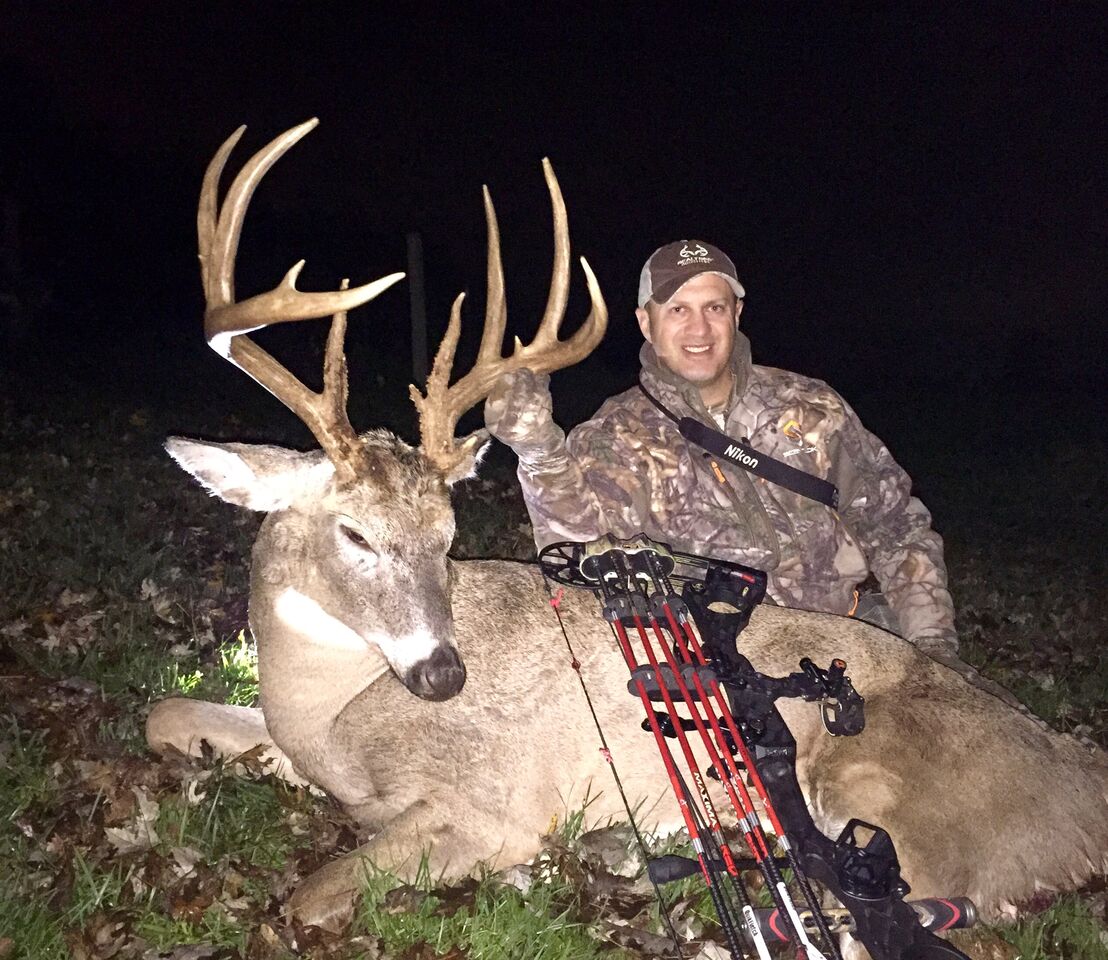
One of Ken’s 2015 bucks
Trooper Kenneth W. Haas #345 Iowa State Patrol
Ken Haas is a native of Omaha Nebraska and lifelong resident of the region. Upon graduating from Millard South High School in 1990 Ken joined the Army National Guard, honorably serving for six years.
Ken received a Bachelor of Science in Criminal Justice from the University of Nebraska-Lincoln in 1996. While working on his B.S. degree, Ken worked as an Intern for both the Nebraska State Patrol and Lincoln Police Department, affirming his desire for a career in law enforcement.
Ken joined the Iowa State Patrol in 1996 and is a 19 year veteran as a State Trooper. Ken served as the Iowa State Patrol Intelligence Officer in 2012, receiving a secret security clearance and was instrumental in implementing the department’s Suspicious Activity Reporting (SAR) initiative. Ken is the lead Criminal Interdiction Instructor at the Iowa DPS Academy, a Drug Interdiction Assistance Program/El Paso Intelligence Center (DIAP/EPIC) certified Instructor, an Associate Instructor for Desert Snow and instructs the Iowa Department of Public Safety (DPS) Law Enforcement Intelligence Network (LIEN) School.
Ken has served in many capacities during his career with the State Patrol including Canine Handler, SWAT team member, Sniper, Hazardous Materials Technician, and Field Training Officer. His dedication to professional development includes more than 600 hours of continued education in interdiction and hundreds of hours in a variety of topics including but not limited to defense tactics, firearms and emergency medical services.
During his career as a Trooper, Ken has been responsible for more than 350 major drug and currency seizures, and involved in more than 600. These seizures include, but are not limited to, more than 23,500 pounds of Marijuana, 10 pounds of heroin, 1,200 pounds of cocaine, 200 pounds of psilocybin mushrooms, 150 pounds of Crystal Methamphetamine and $13M United States currency.
As a direct result of criminal interdiction enforcement Ken has been involved in murder investigations, bank robberies, fraud, theft, weapons, terrorism and a lethal force situation,. Fifteen of the seizures resulted in a controlled delivery of the contraband to further the investigation. These controlled deliveries have resulted in the forfeitures of more than 78 vehicles (53+ were outfitted with after-market compartments designed for concealing and transporting contraband).
Ken is a certified Level III inspector of commercial motor vehicles. His experience with contraband seizures in commercial motor vehicles includes commercial rental trucks, refrigerated trailers with manufactured compartments, dry van trailers with manufactured compartments, car carriers, fifth wheel motor home transporters, Motor coaches, and seizures of contraband co-mingled within legitimate loads. Ken also has many personal use arrests in commercial motor vehicles and one “cloned” AT&T service vehicle.
Ken has traveled to 43 states to train FBI, DEA, Homeland Security, TSA, state and local officers, task force officers and attorneys in criminal and terrorist interdiction. He also travels internationally to provide training for the US Department of Justice International Criminal Investigative Training Assistance Program (ICITAP) and trains stateside for the US Department of Transportation Drug Interdiction Assistance program.
With extensive courtroom testimony experience in both State and Federal courts throughout Iowa and the United States, Ken is considered an expert witness in highway criminal interdiction.
Ken is a proud father of three wonderful children and has served as a State Trooper for 20 years. He is a Taijutsu Blue Belt and when he is not patrolling or instructing Ken is an avid whitetail hunter. He is currently in his 8th year with the television series “Realtree Whitetail Freaks” on the Outdoor Channel.
Ken’s opinions expressed in this blog entry are his own and do not reflect the opinions of the Iowa Department of Public Safety.
A C H I E V E M E N T S A N D A W A R D S
2014 Certificate of appreciation from the Department of Defense and the ICITAP program for providing Criminal Interdiction and Terrorist Training to the Kosovo Police in Pristina Kosovo.
2011 Award from The El Paso Intelligence Center in conjunction with the Drug
Enforcement Administration for “The Largest U.S. Criminal Highway Interdiction Of Currency Seized in 2011.” The seizure of 2,569,955.00 in U.S. Currency.
2011 The Bob Thomason Criminal Interdiction Officer of the Year
United States Department of Transportation/ Federal Motor Carrier Administration/ Drug Interdiction Assistance Program (DIAP)
Criminal Interdiction Officer of the Year, nominated by the former recipients’ of this distinguished award.
2011 Recipient of the 2011 Officer of the year award “Respect For Law 2011”
Optimist Club of Council Bluffs Iowa.
2010 Nominated for the United States Department of Transportation/ Federal Motor Carrier Administration/ Drug Interdiction Assistance Program (DIAP)
Criminal Interdiction Officer of the Year by the former recipients’ of this distinguished award
2010 Recognized by United States Department of Transportation/ Federal Motor Carrier Administration/ DIAP for continued and sustained contributions to highway criminal interdiction.
2009 Recipient of the United States Department of Transportation/ Federal Motor Carrier
Administration/ DIAP “Outstanding Achievement Award”
2008 Golden Dome Award, Iowa State Patrol Interdiction Unit
2007 Colonel’s Commendation for Interdiction
2006 Nominated for Governors Golden Dome Award
2005 Golden Dome Award
2004 United States Attorney’s Office Enrique Camarena Certificate of appreciation
2004 Colonel’s Commendation for apprehension of terrorist subjects.
2003 Nominated Department of Public Safety Employee of the Year Award.
2003 Nominated Governors Golden Dome Award
2003 United States Attorneys Award for excellence in Criminal Interdiction
2003 Drug Enforcement Agency Commendation for Drug Interdiction
2002 Colonels Commendation for criminal interdiction efforts, seizing more than $28.5M in narcotics and $3.2M in US currency
2000 Jimmy Wilson Jr. Foundation Award, for Officer involved shooting.
2000 Iowa Department of Public Safety Commissioner’s Commendation Award
2000 Award for Excellence in Criminal Interdiction, Governor of Iowa
1998 F.B.I. Accommodation for excellence, for the Apprehension of a bank robber
Kristy Lee Cook Q & A – Part 1
August 21st, 2016 by BTC Editor
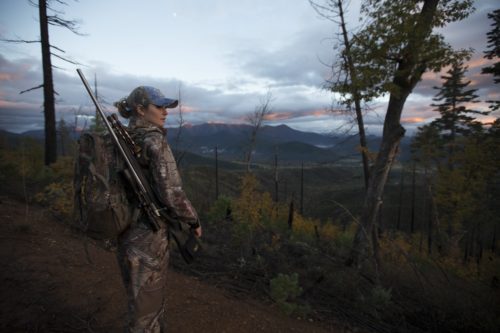
Kristy Lee Cook is most known for being a top 10 Finalist on Season 7 of “American Idol”. She has since stayed in the spotlight and is currently co-hosting “The Most Wanted List” on the Sportsman Channel, along with her 2 friends Jess and Jessi Jo. We recently sat down with Kristy to find out more about her and her love for singing, hunting and all things Browning.
BTC: You are co-host for “The Most Wanted List” on the Sportsman Channel, along with your friends Jessi Jo and Jess. Tell us a little about the concept of this show.
KLC: The show is basically about just having adventures and bringing along friends and family. It’s really fun because we get to bring out a lot of different people on the show. I brought my brother on and we bring celebrities on. It’s just really about showing what it is to share adventures and doing everything you’ve wanted to do in life. A lot of people say there’s things they want to do, and then never do them. We actually go and do them. A lot of people just say it, and they never get the chance to do and see things, so the whole point of the show is to go on these adventures, everything we’ve wanted to do in life, like hunts and anything else we can think of and we go and do it.

BTC: You’re all 3 barrel racers and you (KLC) travel all over the country for that as well to compete in competitions?
KLC: Yes, I do. I’m actually in Texas right now for a competition and I was in Utah and California before that.
BTC: Which do you find to be more of a rush: barrel racing, singing in front of a big crowd, or shooting a big buck?
KLC: Oh boy! Well, I don’t get buck fever. I would say the most nerve-racking thing for me is singing the National Anthem. It’s such a hard song to sing and if you mess it up you’re known for life for messing it up. So that’s probably the most nerve-racking thing for me. I do get nervous
BTC: I’m sure you’ve had the opportunity to hunt with some well-known people. What is one person that you would like to hunt with one day that you haven’t yet & why?
KLC: I would really like to hunt with my sister again. That would be a lot of fun. I took her on her very first hunt and that’s the only hunt she’s ever been on so I’d like to take her again one day. I’m actually going to have one of my other best friends on the show. I kind of just want to bring on my friends and family and help people go on hunts and adventures that they’ve always wanted to do.
BTC: You had a Camaro completely wrapped in camo with the Browning Buck Mark on the hood, so it’s safe to say you’re in love with the Browning brand. How did your love for Browning start?
KLC: Well I’ve just always loved Browning. I came up to them one day and said I would love to put your logo on my car. It’s good advertising and I’m a Browning girl and I want to camouflage my car. So I talked to them about it and they said it would be great if I wanted to do that. I’ve always wanted a camouflage Camaro so I did it! It was just cool.
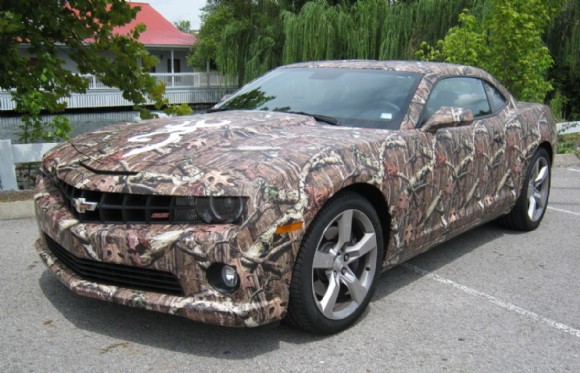
BTC: Was yours was the only one out there like that?
KLC: It was the only one in the world. I did see a few cars get done like that after I did mine, but it was pretty neat having the only car in the world like that. You’d find either people liked it, or didn’t like it. For the people that didn’t like it I was like, “Well, I have the ONLY one in the world like this”. I liked it!
BTC: Any good stories about that Camaro? Drag racing? Tickets? Burnouts?
KLC: Actually yes! I’m so used to driving trucks so when I had my Camaro, I was in Nashville and I was going 80 down the freeway in a 65 zone. I didn’t feel like I was going 83 at all because it just drove so fast and smooth. I got a ticket for that for sure.
I couldn’t take it anywhere without people wanting to take a picture of it. I would be in the gas station in my PJ’s and people would still want to stop and take a picture with me and my car.
I also have a little bit of road rage, so everybody knew it was me who was cutting them off!
Stay tuned for Part 2 of our Q & A with Kristy Lee Cook, to be posted at Huntress View
Bowhunting: Tips For Mental Preparation
August 7th, 2016 by BTC Editor
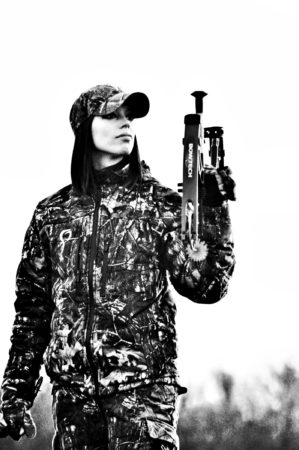
Whitetail archery season is right around the corner! Most likely you’ve spent the past few months or more preparing yourself physically by practicing daily and getting into shape. Being physically fit definitely helps, especially for those who spot and stalk hunt. But being prepared mentally is just as important and is commonly overlooked while preparing for bow hunting.
If you’ve been hunting for a while, you probably have a good idea of how you typically react when a buck walks under your stand and how well you’re able to keep your cool. But if you’re new to hunting altogether, preparing for your first bow hunt can be a little more of a challenge. You’re still working on getting your shooting form down, on top of being nervous about what to expect during your first bow season.
Here are a few things that may help you when preparing yourself mentally for your first bow hunt, your first deer harvest with a bow, or even for those who have had some recent onsets of buck fever and are having trouble getting past that.
Practice
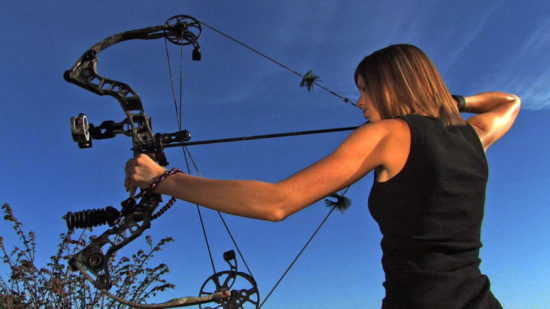
Keep in mind that shooting at a deer from your tree stand or blind is a totally different ball game than just practicing in your backyard. It’s much easier to make a great shot at a target while you’re not under any kind of pressure than it is at a live animal when your adrenaline is pumping. Plus, mother nature can throw some curve balls at you, making it that much more of a challenge.
I think one of the best ways to prepare yourself for shooting at a live animal is to force yourself to practice in ways that simulate real world hunting scenarios. Try shooting at low light, on a windy day or in an uncomfortable position. While you’re hunting you will very likely experience all 3 of those situations, and there’s a good possibility that’s when the buck of a lifetime will step out.
Envision The Shot
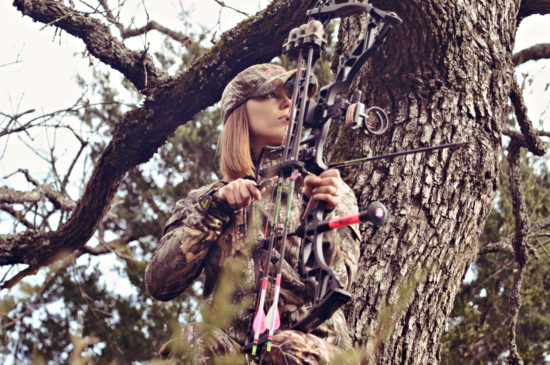
Bow hunting is definitely a mental game. If you go into a hunt with a negative attitude or start doubting yourself, you’re probably going to mess up a shot opportunity. Stay positive and visualize yourself making a great shot on a deer. I will often play out different scenarios in my head to better prepare myself. I check my surroundings and make mental notes on when I think I will be able to draw my bow if the deer were to come from my right, my left, or the front, etc. Whitetail have a mind of their own and you can bet that they probably won’t do what you have in mind. It’s good to expect the unexpected.
Just Breathe
When you are preparing to shoot, just take a few breaths to calm your nerves. I know you may not always have the time to do this, as deer can come in pretty fast and often give you just a few seconds to make a shot. But if you’re watching a deer slowly making its way towards you and you feel like your heart is going to beat out of your chest by the time it gets within shooting range, I highly recommend closing your eyes & just breathing for a few seconds. It really does help.
Know Your Limits
If a deer steps out and it’s too dark to make an ethical shot or it’s just a little farther than what you are comfortable with, don’t force it. One of the best ways to break your confidence is to make a bad shot on an animal. If you’ve been hunting long enough you will mess up sometimes, as none of us are perfect. Just make sure you aren’t messing up because you’re pushing yourself past your limits. When in doubt, just pass on the shot.
Hunt Alone If Necessary
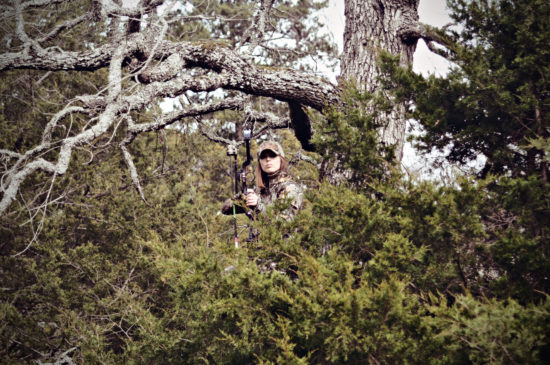
This may not seem like an issue, but for me it is. I get more nervous when there’s someone in the stand watching me than if I were to just hunt alone. My first deer with both rifle and bow were during solo hunts and I preferred it that way. I had practiced enough that I was confident in my shooting ability and didn’t want to listen to another person’s voice telling me what to do, on top of trying to listen to the voice in my head as well. For me, that worked and I feel it helped me stay more focused. That may not work for everyone though, so if you feel you need someone there to help guide you through it, that’s ok too.
Experience is the best teacher with bow hunting, but unfortunately when you’re new to it you don’t have that luxury. The best thing you can do is just make sure you’re as prepared as possible, both physically and mentally, for whatever this bow season may throw at you.
Good luck this season!

Andrea Haas
Andrea Haas is a Pro-Staffer from Missouri who enjoys turkey hunting, deer hunting and bowhunting. She is also the founder of the Huntress View, an organization formed to help strengthen the ever growing community of women hunters.
